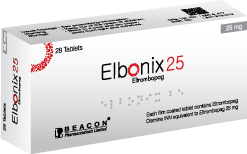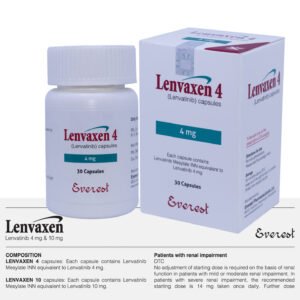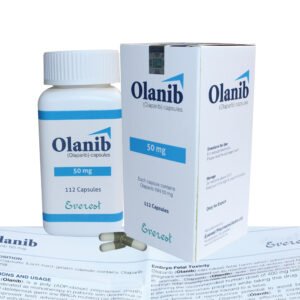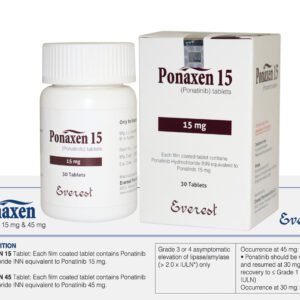Description
Composition:
Elbonix 25 tablet: Each film-coated tablet is formulated with Eltrombopag Olamine INN, equating to 25 mg of Eltrombopag.
Therapeutic Classification:
Blood Formation Agent
Pharmacological Profile
Action Mechanism:
Eltrombopag, available for oral administration, is a TPO-receptor agonist that binds to the receptor’s transmembrane domain, initiating signaling pathways that stimulate bone marrow progenitor cell growth and maturation.
Pharmacokinetics:
Absorption: Maximum concentration of Eltrombopag is reached 2-6 hours post-administration. The drug demonstrates at least 52% oral absorption from a single 75-mg dose.
Distribution: Eltrombopag’s blood cell concentration is 50% to 79% of its plasma concentration. It is highly plasma protein-bound (>99%) and metabolized by BCRP, not by P-gp or OATP1B1.
Metabolism: Extensively metabolized through cleavage, oxidation, and conjugation. CYP1A2 and CYP2C8 are primary enzymes for oxidative metabolism, with UGT1A1 and UGT1A3 handling glucuronidation.
Elimination: Mainly excreted via feces (59%) and urine (31%), with about 20% of the dose excreted unchanged in feces. Eltrombopag’s plasma elimination half-life ranges from 21 to 32 hours.
Dosage and Administration:
Chronic Immune (Idiopathic) Thrombocytopenia (ITP)
Administer the lowest effective dose to maintain a platelet count above 50 x 10^9/L to minimize bleeding risk. Adjust dose based on platelet response, aiming for a gradual increase within 1-2 weeks of treatment initiation.
Initial Dosage: For adults and children over 6 years with ITP, start at 25 mg daily, adjusted based on patient response and specific conditions such as ethnicity or liver impairment.
Dose Adjustment and Monitoring: Adjust the dose to maintain desired platelet counts, with regular blood count and liver function monitoring.
Use in Specific Populations
Pregnancy: Category C. Assess the benefit-risk ratio before administration.
Nursing Mothers: Consider discontinuing the drug or breastfeeding due to potential adverse effects.
Pediatric Use: Established safety and efficacy for chronic ITP in patients 1 year and older. The appropriate starting dose is 25 mg daily.
Geriatric Use: No significant differences in safety or effectiveness observed between older and younger patients.
Hepatic Impairment: Initial dose adjustment recommended.
Renal Impairment: No adjustment needed in the initial dose.
Ethnic Considerations: Dose adjustments may be necessary for patients of East Asian ancestry due to higher exposures.
Warnings and Precautions
Monitor for hepatotoxicity and thrombotic/thromboembolic complications. Regularly check liver function and platelet counts.
Side Effects:
Common side effects include nausea, diarrhea, upper respiratory infections, and increased liver enzymes.
Contraindications:
There are no known contraindications.
Drug Interactions:
Avoid intake within 2 hours before or 4 hours after consuming products containing polyvalent cations.
Overdose Management:
Monitor platelet counts closely and consider chelation therapy in cases of significant overdose.
Pharmaceutical Information:
Storage:
Store in a cool, dry place away from light. Keep out of reach of children.
Packaging:
Elbonix 25 Tablet: Packaged in 28-tablet Alu-Alu blister packs.





